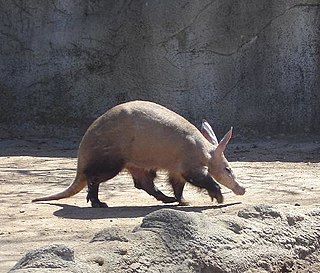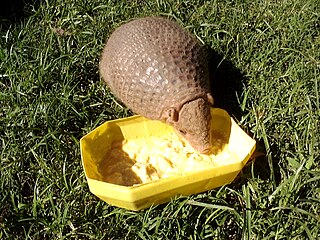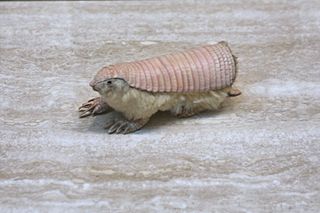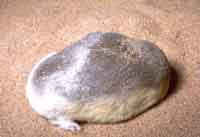 W
WThe aardvark is a medium-sized, burrowing, nocturnal mammal native to Africa. It is the only living species of the order Tubulidentata, although other prehistoric species and genera of Tubulidentata are known. Unlike other insectivores, it has a long pig-like snout, which is used to sniff out food. It roams over most of the southern two-thirds of the African continent, avoiding areas that are mainly rocky. A nocturnal feeder, it subsists on ants and termites, which it will dig out of their hills using its sharp claws and powerful legs. It also digs to create burrows in which to live and rear its young. It receives a "least concern" rating from the IUCN, although its numbers seem to be decreasing.
 W
WThe aardwolf is an insectivorous mammal, native to East and Southern Africa. Its name means "earth-wolf" in Afrikaans and Dutch. It is also called "maanhaar-jackal", "|gīb" by the Nama people, "ant hyena", "termite-eating hyena" and "civet hyena", based on its habit of secreting substances from its anal gland, a characteristic shared with the African civet. The aardwolf is in the same family as the hyena. Unlike many of its relatives in the order Carnivora, the aardwolf does not hunt large animals. It eats insects and their larvae, mainly termites; one aardwolf can lap up as many as 250,000 termites during a single night using its long, sticky tongue, the aardwolves tongue has adapted to be tough enough to withstand the strong bite of termites.
 W
WThe Brazilian three-banded armadillo is an armadillo species endemic to eastern Brazil, where it is known as tatu-bola. It is one of only two species of armadillo that can roll into a ball. It has suffered a 30% decline in population in the last 10 years.
 W
WThe Chacoan naked-tailed armadillo is a species of South American armadillo.
 W
WThe giant armadillo, colloquially tatou, ocarro, tatu-canastra or tatú carreta, is the largest living species of armadillo. It lives in South America, ranging throughout as far south as northern Argentina. This species is considered vulnerable to extinction.
 W
WThe greater naked-tailed armadillo is an armadillo species from South America.
 W
WThe Llanos long-nosed armadillo is a species of armadillo in the family Dasypodidae. It is endemic to Colombia and Venezuela, where its habitat is the intermittently flooded grassland of the Llanos. The species is closely related to the nine-banded armadillo and the great long-nosed armadillo. It has very little hair and can weigh up to 22 pounds (9.5 kg), and can grow to about 2.1 feet (60 cm) long. It lives in dense cover near limestone formations. Like most other armadillos, it eats ants.
 W
WThe northern naked-tailed armadillo is a species of armadillo. It is one of only two species of armadillo found outside of South America, the other being the more widely distributed nine-banded armadillo.
 W
WThe pink fairy armadillo or pichiciego is the smallest species of armadillo, first described by Richard Harlan in 1825. This solitary, desert-adapted animal is endemic to central Argentina and can be found inhabiting sandy plains, dunes, and scrubby grasslands.
 W
WThe southern long-nosed armadillo is a species of armadillo native to South America.
 W
WThe southern naked-tailed armadillo is a species of small armadillo from South America.
 W
WThe southern three-banded armadillo, also called the Bolivian three-banded armadillo, is an armadillo species from South America. It is found in parts of northern Argentina, southwestern Brazil, Paraguay and Bolivia, at elevations from sea level to 770 m (2,530 ft).
 W
WThe sloth bear is a myrmecophagous bear species native to the Indian subcontinent. It feeds on fruits, ants and termites. It is listed as Vulnerable on the IUCN Red List, mainly because of habitat loss and degradation.
 W
WThe short-beaked echidna, sometimes also referred to as the common echidna or the Australian echidna is one of four living species of echidna and the only member of the genus Tachyglossus. It is covered in fur and spines and has a distinctive snout and a specialized tongue, which it uses to catch its insect prey at a great speed. Like the other extant monotremes, the short-beaked echidna lays eggs; the monotremes are the only group of mammals to do so.
 W
WEomanis is the earliest known true pangolin. It lived during the Eocene in Europe. Eomanis fossils found in the Messel Pit in Germany are very similar in size and anatomy to living pangolins of the genus Manis, indicating that pangolins have remained largely unchanged in morphology and behavior for 50 million years. However, unlike modern pangolins, its tail and legs did not bear scales. According to the stomach contents of the excellently preserved Messel specimens, Eomanis’ diet consisted of both insects and plants.
 W
WEpoicotheriidae is an extinct family of pangolin-like insectivorous mammals which were endemic to North America from the early Eocene to the early Oligocene 55.8—30.9 Ma existing for approximately 24.9 million years . Epoicotheriids were highly specialized animals that were convergent with the golden moles of Africa in the structure of their skulls and forelimbs, and would have had a similar lifestyle as subterranean burrowers.
 W
WErnanodontidae is an extinct family of pangolin-like insectivorous mammals which were endemic to Asia from the late Paleocene to the early Eocene, 58.7—55.8 Ma existing for approximately 2.9 million years .
 W
WEurotamandua is an extinct genus of mammal that lived some 47 million years ago, during the early Eocene.
 W
WThe bat-eared fox is a species of fox found on the African savanna. It is the only extant species of the genus Otocyon and considered a basal canid species. Fossil records show this canid to first appear during the middle Pleistocene.
 W
WFruitafossor was a termite-eating mammal endemic to North America during the Late Jurassic epoch.
 W
WGrant's golden mole is a golden mole species. It is the only member of the genus Eremitalpa.
 W
WNecromanis is an extinct genus of pholidotan from the Oligocene and Miocene of France. It was originally placed within Manidae, but was eventually removed from it as more fossil pholidotids from outside that family were found and studied more extensively. Currently, Necromanis is placed as incertae sedis within the pholidotid superfamily Manoidea, together with the families Manidae and Patriomanidae.
 W
WThe numbat is an insectivorous marsupial native to Western Australia and recently re-introduced to fenced reserves in South Australia and New South Wales. The species is also known as the noombat or walpurti. Its diet consists almost exclusively of termites. Once widespread across southern Australia, its range is now restricted to several small colonies and it is considered an endangered species. The numbat is an emblem of Western Australia and protected by conservation programs.
 W
WPangolins, sometimes known as scaly anteaters, are mammals of the order Pholidota. The one extant family, Manidae, has three genera: Manis, Phataginus and Smutsia. Manis comprises the four species found in Asia, while Phataginus and Smutsia include two species each, all found in sub-Saharan Africa. These species range in size from 30 to 100 cm. A number of extinct pangolin species are also known.
 W
WThe Chinese pangolin is a pangolin native to the northern Indian subcontinent, northern parts of Southeast Asia and southern China. It has been listed as Critically Endangered on the IUCN Red List since 2014, as the wild population is estimated to have declined by more than 80% in three pangolin generations, equal to 21 years. It is threatened by poaching for the illegal wildlife trade.
 W
WThe giant pangolin is the largest species in the family of pangolins or scaly anteaters. Members of the species inhabit Africa with a range stretching along the equator from West Africa to Uganda. It subsists almost entirely on ants and termites. The species was first described by Johann Karl Wilhelm Illiger in 1815.
 W
WThe ground pangolin, also known as Temminck's pangolin, Cape pangolin or steppe pangolin, is one of four species of pangolins which can be found in Africa, and the only one in southern and eastern Africa. The animal was named for the Dutch zoologist Coenraad Jacob Temminck. As a group, pangolins are among the most critically endangered animals in the world.
 W
WThe Indian pangolin, also called thick-tailed pangolin and scaly anteater is a pangolin native to the Indian subcontinent.
 W
WThe Philippine pangolin or Palawan pangolin, also locally known as balintong, is a pangolin species endemic to the Palawan province of the Philippines. Its habitat includes primary and secondary forests, as well as surrounding grasslands. This species is moderately common within its limited range, but is at risk due to heavy hunting because of its valued scales and meat. This species is distinguished from the closely related Sunda pangolin by its smaller body-to-tail ratio, smaller scales, and a shorter head. It is listed as Critically Endangered by the IUCN, and Critically Endangered by the Palawan Council for Sustainable Development (PCSD).
 W
WThe Sunda pangolin, also known as the Malayan or Javan pangolin, is a species of pangolin.
 W
WPatriomanis is an extinct genus of pangolin from the Eocene of North America. It currently represents the only pholidotan known from the Western Hemisphere. The genus contains one species, P. americana, which is known from six specimens, mostly from the Chadronian White River Formation of Montana. It had long digits and a prehensile tail, suggesting that it was arboreal, and its jaw was capable of opening wider than modern pangolins. Its ears and the hair between its scales were also longer than modern pangolins.
 W
WThe genus Tolypeutes contains the two species of three-banded armadillos. They are restricted to open and semi-open habitats in South America.